<< Previous | Displaying results 4571-4580 of 6776 for "" | Next >>
Close-up of corpses piled in the crematorium mortuary in the newly liberated Dachau concentration camp. Dachau, Germany, May 1945. This image is among the commonly reproduced and distributed, and often extremely graphic, images of liberation. These photographs provided powerful documentation of the crimes of the Nazi era.
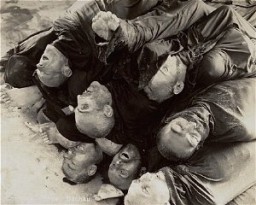
View of the main street of the Nordhausen concentration camp, outside of the central barracks (Boelke Kaserne), where the bodies of prisoners have been laid out in long rows. Nordhausen, Germany, April 13–14, 1945. This image is among the commonly reproduced and distributed, and often extremely graphic, images of liberation. These photographs provided powerful documentation of the crimes of the Nazi era.
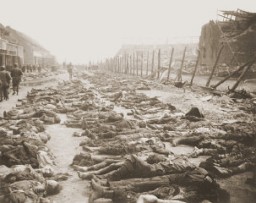
German civilians under US military escort are forced to view a wagon piled with corpses in the newly liberated Buchenwald concentration camp. Buchenwald, Germany, April 16, 1945.
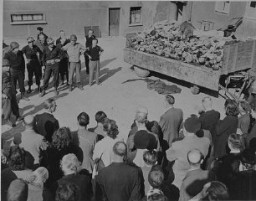
A wagon is piled with the bodies of victims of the Buchenwald concentration camp. Photograph taken following the liberation of the camp. The 6th Armored Division overran the camp on April 11, 1945. Buchenwald, Germany, April 11–May 1945.
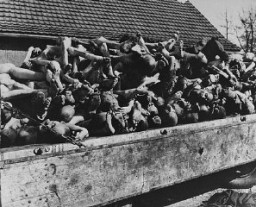
Former prisoners of the "little camp" in Buchenwald stare out from the wooden bunks in which they slept three to a "bed." Elie Wiesel is pictured in the second row of bunks, seventh from the left, next to the vertical beam. Abraham Hipler is pictured in the second row, fourth from the left. The man on the third bunk from the bottom, third from the left, is Ignacz (Isaac) Berkovicz. [He has also been identified as Abraham Baruch.] Michael Nikolas Gruner, originally from Hungary, is pictured on the bottom…
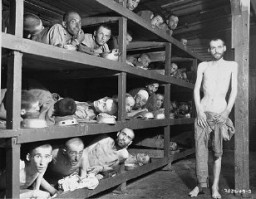
The bodies of former prisoners are stacked outside the crematorium in the newly liberated Buchenwald concentration camp. Buchenwald, Germany, April 23, 1945. This image is among the commonly reproduced and distributed, and often extremely graphic, images of liberation. These photographs provided powerful documentation of the crimes of the Nazi era.
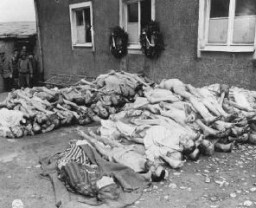
A wagon is piled high with the bodies of victims of the Buchenwald concentration camp. Photograph taken following the liberation of the camp. Buchenwald, Germany, April 16, 1945.
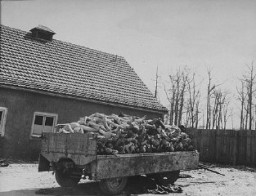
The charred corpse of a prisoner killed by the SS in a barn just outside of Gardelegen. The SS guards locked the prisoners, who were on a death march from the Dora-Mittelbau camp, in a barn, which was then set ablaze. Gardelegen, Germany, April 16, 1945. This image is among the commonly reproduced and distributed, and often extremely graphic, images of liberation. These photographs provided powerful documentation of the crimes of the Nazi era.
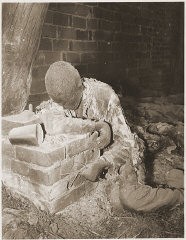
The charred remains of former prisoners in two crematoria ovens in the newly liberated Buchenwald concentration camp. Buchenwald, Germany, April 14, 1945. This image is among the commonly reproduced and distributed, and often extremely graphic, images of liberation. These photographs provided powerful documentation of the crimes of the Nazi era.
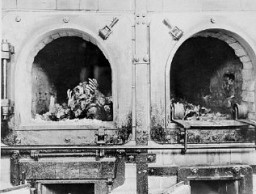
Two ovens inside the crematorium at the Dachau concentration camp. Dachau, Germany, July 1, 1945. This image is among the commonly reproduced and distributed images of liberation. These photographs provided powerful documentation of the crimes of the Nazi era.
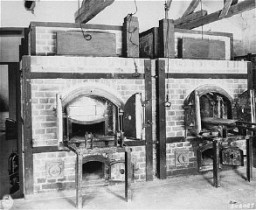
We would like to thank Crown Family Philanthropies, Abe and Ida Cooper Foundation, the Claims Conference, EVZ, and BMF for supporting the ongoing work to create content and resources for the Holocaust Encyclopedia. View the list of donor acknowledgement.